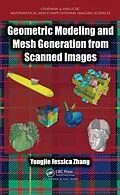Cutting-Edge Techniques to Better Analyze and Predict Complex Physical Phenomena
Geometric Modeling and Mesh Generation from Scanned Images shows how to integrate image processing, geometric modeling, and mesh generation with the finite element method (FEM) to solve problems in computational biology, medicine, materials science, and engineering. Based on the author's recent research and course at Carnegie Mellon University, the text explains the fundamentals of medical imaging, image processing, computational geometry, mesh generation, visualization, and finite element analysis. It also explores novel and advanced applications in computational biology, medicine, materials science, and other engineering areas.
One of the first to cover this emerging interdisciplinary field, the book addresses biomedical/material imaging, image processing, geometric modeling and visualization, FEM, and biomedical and engineering applications. It introduces image-mesh-simulation pipelines, reviews numerical methods used in various modules of the pipelines, and discusses several scanning techniques, including ones to probe polycrystalline materials.
The book next presents the fundamentals of geometric modeling and computer graphics, geometric objects and transformations, and curves and surfaces as well as two isocontouring methods: marching cubes and dual contouring. It then describes various triangular/tetrahedral and quadrilateral/hexahedral mesh generation techniques. The book also discusses volumetric T-spline modeling for isogeometric analysis (IGA) and introduces some new developments of FEM in recent years with applications.
Autorentext
Yongjie Jessica Zhang is an associate professor in the Department of Mechanical Engineering at Carnegie Mellon University with a courtesy appointment in the Department of Biomedical Engineering. She is the co-author of more than 130 publications in peer-reviewed international journals and conference proceedings. She has been a recipient of the Presidential Early Career Award for Scientists and Engineers, NSF CAREER Award, Office of Naval Research Young Investigator Award, USACM Gallagher Young Investigator Award, Clarence H. Adamson Career Faculty Fellow in Mechanical Engineering, George Tallman Ladd Research Award, and Donald L. and Rhonda Struminger Faculty Fellow. Her research interests include computational geometry, mesh generation, computer graphics, visualization, finite element method, isogeometric analysis, and their application in computational biomedicine and engineering. She earned a PhD in computational engineering and sciences from the Institute for Computational Engineering and Sciences (ICES) at the University of Texas at Austin.
Inhalt
Introduction and Pipelines
Introduction
Pipelines and Five Topics
Challenges and Advances
Review of Numerical Methods
Introduction
Linear and Nonlinear Algebraic Equations Curve Fitting
Ordinary Differential Equations
Eigenvalue Problems
Partial Differential Equations
Numerical Integration
Fourier Analysis
Optimization
Scanning Techniques and Image Processing
Scanning Techniques
Basic Operations
Filtering
Segmentation
Registration
Fundamentals to Geometric Modeling and Meshing
Fundamentals
Geometric Objects and Transformations
Curves and Surfaces
Spline-Based Modeling
Isocontouring and Visualization
Image-Based Triangular and Tetrahedral Mesh Generation
A Review of Unstructured Triangular and Tetrahedral Meshing
Octree-Based Triangular and Tetrahedral Meshing from Images
Resolving Topology Ambiguities
Quality Improvement
Image-Based Quadrilateral and Hexahedral Mesh Generation
A Review of Unstructured Quadrilateral and Hexahedral Meshing
Octree-Based Quadrilateral and Hexahedral Meshing from Images
Sharp Feature Preservation for CAD Assemblies
Octree vs RD-Tree Based Adaptive Hexahedral Meshing
Quality Improvement
Volumetric T-Spline Modeling
Introduction
Converting Unstructured Quadrilateral and Hexahedral Meshes to T-Splines
Polycube-Based Parametric Mapping Methods
Eigenfunction-Based Surface Parameterization
Truncated Hierarchical Catmull-Clark Subdivision Modeling
Weighted T-Spline and Trimmed Surfaces
Incorporating T-Splines into Commercial Software
Finite Element and Isogeometric Analysis Applications
Introduction to Finite Element Method and Its New Developments
Multiscale Biomolecular Modeling
Patient-Specific Geometric Modeling for Cardiovascular Systems
Applications in Materials Science
